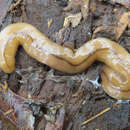en
names in breadcrumbs


Bipalium adventitium ist eine Art der zu den Plattwürmern zählenden Landplanarien in der Unterfamilie Bipaliinae. Sie ist in Asien heimisch und hat sich in jüngerer Zeit auf Nordamerika ausgebreitet.[1]
Die meisten ausgewachsenen Individuen von Bipalium adventitium haben eine Länge von 5 bis 8 Zentimetern. Der Kopf ist fächerartig verbreitert. Von anderen Arten der Gattung Bipalium, wie Bipalium kewense, kann man Bipalium adventitium leicht unterscheiden, da diese Arten einen halbmondförmigen Kopf haben.[1] Der Körper hat eine gelbe bis hellbraune Färbung und einen dunklen Längsstreifen, der jedoch nicht über den Kopf verläuft.[2]
Bipalium adventitium ist bekannt dafür, Regenwürmer zu jagen. Um die Beute zu fangen, ist es ihnen möglich, der Spur der Regenwürmer zu folgen, die durch von ihnen abgegebene chemische Stoffe entsteht.[3] Am Kopf sitzen Chemorezeptoren, mit denen die von der Beute hinterlassene Spur wahrgenommen werden kann.[4] Nachdem ein Regenwurm gefunden wurde, kriecht die Landplanarie über ihn und wickelt ihren Körper um seinen, um die Flucht zu verhindern. In Nordamerika, wo Bipalium adventitium als invasive Art lebt, erkennen die meisten Regenwürmer die Planarie nicht als Prädator. Sie versuchen erst zu fliehen, wenn die Planarie mit ihrem Pharynx in ihren Körper eindringt. Dies ist der Grund dafür, dass Bipalium adventitium eine erfolgreiche Art im neuen Lebensraum ist.[3]
In einer Studie konnte nachgewiesen werden, dass Bipalium adventitium das starke Nervengift Tetrodotoxin, das erstmals in Kugelfischen entdeckt wurde, enthält. Die Landplanarie war mit der verwandten Bipalium kewense der erste landlebende Organismus, in dem das Gift gefunden wurde. Es ist jedoch unbekannt, ob dieses Gift bei dem Schutz vor Feinden oder beim Fangen der Beute eine Rolle spielt.[5]
Im Gegensatz zur Landplanarie Bipalium kewense, die sich asexuell fortpflanzt, vermehrt sich Bipalium adventitium sexuell. Vermutlich gibt es nur einen Begattungszeitraum pro Jahr.[2] Wie bei den meisten Landplanarien erfolgt eine innere Befruchtung, wenn sich zwei Individuen paaren. Die Eier werden als Eikapseln abgelegt, aus denen nach ungefähr drei Wochen ein bis sechs Jungtiere schlüpfen.[6]
Die ursprünglich in Asien heimische Art wurde vermutlich unabsichtlich im 20. Jahrhundert in die nördlichen Bundesstaaten der USA eingeführt und hat sich seither dort stark vermehrt.[7] In Vororten und in Anlagen, in denen exotische Pflanzen angebaut werden, wird Bipalium adventitium besonders häufig gefunden.[2] Im Jahr 2019 wurde die Art erstmals in Montréal in Kanada nachgewiesen.[8]
Das Artepitheton adventitium (von außen kommend, ausländisch, fremd[9]) verweist auf die Einführung aus einem fernen Land.
Bipalium adventitium ist eine Art der zu den Plattwürmern zählenden Landplanarien in der Unterfamilie Bipaliinae. Sie ist in Asien heimisch und hat sich in jüngerer Zeit auf Nordamerika ausgebreitet.
Bipalium adventitium is a land planarian in the subfamily Bipaliinae. It has been accidentally introduced in the United States, where it is considered invasive.[1]
Most adult individuals of B. adventitium are 5–8 cm (2.0–3.1 in) in length. The head is expanded and fan-shaped, being easily distinguishable from other common species of Bipalium, such as Bipalium kewense and Bipalium pennsylvanicum, because these have a head in the shape of a half moon.[1] The body has a yellow to tan color and has one dark dorsal stripe that does not extend over the head.[2]
Bipalium adventitium is known to prey on earthworms. In order to catch its prey, it follows a chemical trail given off by the earthworm.[3] Chemoreceptors on the head are responsible for sensing the trail left by the prey.[4] After finding an earthworm, the planarian quickly crawls over it and wraps itself around the prey, preventing its escape. In North America, where B. adventitium is an introduced species, most earthworms do not immediately recognize the flatworm as a predator. They try to escape only after being pierced by the planarian's everted pharynx, which is one of the reasons of B. adventitium's success in invading this continent.[3]
Recently, it has been confirmed that the potent neurotoxin tetrodotoxin is present in B. adventitium. Its function is yet unknown, but it may be used as a defense against predators or as a way to subdue prey.[5]
Differently from Bipalium kewense, which usually reproduces asexually by fission, Bipalium adventitium more commonly reproduces sexually. It is suggested that it has only one breeding season per year.[2] As in most land planarians, mating occurs by internal fertilization when two individuals meet. The eggs are deposited in egg capsules and after about 3 weeks they release 1–6 juveniles.[6]
Bipalium adventitium is believed to have been introduced in the last century to the United States from Asia. It is believed that this broadhead planarian was introduced and spread to most Northern states passively by human dispersal and has become abundant in the region it occupies.[7] It is more commonly found in suburban areas and nurseries where exotic plants are prevalent.[2] It is found in gardens and woodlands under objects like leaf litter, where the soil is moist. The ecological consequences of this invasion have not yet been fully explored.
In 2019, the species has been recorded for the first time in Montréal, Quebec, Canada.[8]
Bipalium adventitium is a land planarian in the subfamily Bipaliinae. It has been accidentally introduced in the United States, where it is considered invasive.